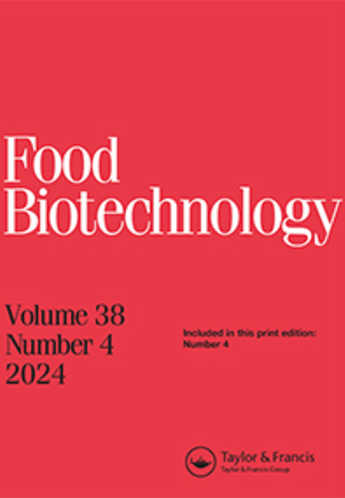新型电位生物传感器选择性测定马苏里拉奶酪中的赖氨酸
IF 1.6
4区 农林科学
Q4 BIOTECHNOLOGY & APPLIED MICROBIOLOGY
引用次数: 1
摘要
赖氨酸的分析为相关食品行业带来了巨大的成本。使用酶传感器可以减少分析的时间和成本。本研究将赖氨酸-α-氧化酶(LOx)与溶解酶传感器结合氧电极进行优化,用于测定马苏里拉奶酪中赖氨酸的含量。选择性测定马苏里拉奶酪中赖氨酸的含量是质量和成熟时间的指标。赖氨酸氧化过程中耗氧(耗氧)得到的电位信号在可溶性酶传感器中进行了100秒的测量。根据反应速率斜率计算出测定赖氨酸含量的最佳时间传感器响应为3.5s。传感器的电位设置为0.6 mV。在30 ~ 1300µM范围内,耗氧量(mg O2/L × s)与赖氨酸浓度呈线性正相关(R2 = 0.9968)。该系统具有良好的特异性(KM = 0.03 mM),并在8周的奶酪成熟时间内持续存在。用可溶性酶传感器对马苏里拉奶酪样品中的赖氨酸进行了分析,结果与标准高效液相色谱法的测定结果非常吻合,验证了该传感器作为一种替代的、更有效的乳制品评价技术的应用。本文章由计算机程序翻译,如有差异,请以英文原文为准。
Selective determination of lysine in mozzarella cheese using a novel potentiometric biosensor
ABSTRACT The analysis of lysine represents a significant cost for the relevant food industries. The use of an enzymatic sensor would allow the reduction of time and cost of this analysis. An enzymatic sensor using lysine -α- oxidase (LOx) with a soluble enzyme sensor in combination with an oxygen electrode was optimized in this study to determine the lysine content in mozzarella cheese. Selective determination of lysine in mozzarella cheese is an indicator of quality and of ripening time. The potentiometric signal obtained due to oxygen depletion (consumed oxygen) during lysine oxidation was carried out during 100s in the soluble enzyme sensor. An optimal time sensor response to quantify the lysine content of 3.5s was calculated from the slope of reaction rates. The sensor was set at a potential of 0.6 mV. A positive linear relationship was found between consumed oxygen as a function of time (mg O2/L × s) and lysine concentration in the range of 30–1,300 µM, with a coefficient of R2 = 0.9968 for the soluble enzyme sensor. This system showed good specificity (KM = 0.03 mM), which continued during eight weeks of cheese ripening time. The analysis of lysine with the soluble enzyme sensor in mozzarella cheese samples revealed very good agreement with the determination performed through standard HPLC methodology, which validated the use of this sensor as an alternative and more efficient technique to evaluate dairy products.
求助全文
通过发布文献求助,成功后即可免费获取论文全文。
去求助
来源期刊

Food Biotechnology
工程技术-生物工程与应用微生物
CiteScore
3.80
自引率
0.00%
发文量
15
审稿时长
>12 weeks
期刊介绍:
Food Biotechnology is an international, peer-reviewed journal that is focused on current and emerging developments and applications of modern genetics, enzymatic, metabolic and systems-based biochemical processes in food and food-related biological systems. The goal is to help produce and improve foods, food ingredients, and functional foods at the processing stage and beyond agricultural production.
Other areas of strong interest are microbial and fermentation-based metabolic processing to improve foods, food microbiomes for health, metabolic basis for food ingredients with health benefits, molecular and metabolic approaches to functional foods, and biochemical processes for food waste remediation. In addition, articles addressing the topics of modern molecular, metabolic and biochemical approaches to improving food safety and quality are also published.
Researchers in agriculture, food science and nutrition, including food and biotechnology consultants around the world will benefit from the research published in Food Biotechnology. The published research and reviews can be utilized to further educational and research programs and may also be applied to food quality and value added processing challenges, which are continuously evolving and expanding based upon the peer reviewed research conducted and published in the journal.
 求助内容:
求助内容: 应助结果提醒方式:
应助结果提醒方式:


